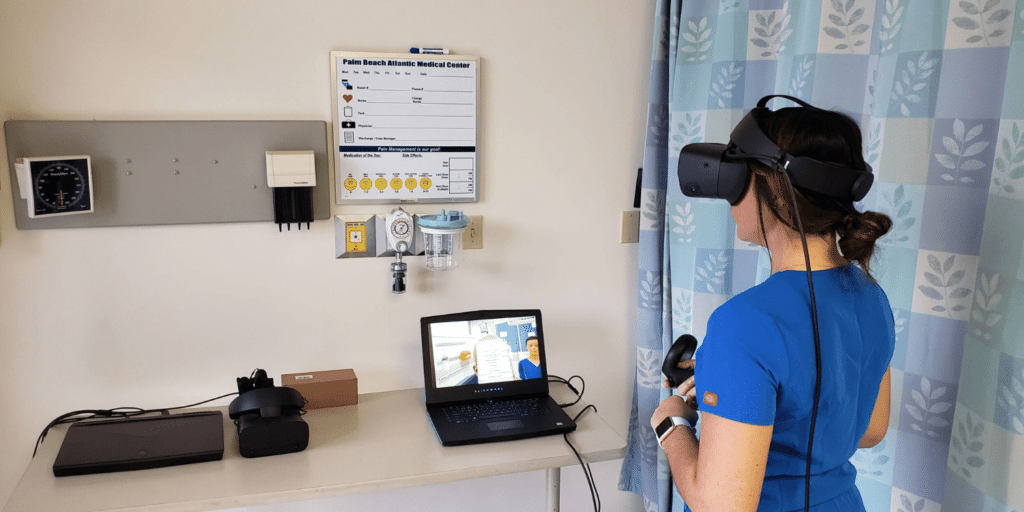Since 2016, US hospitals have turned over an average of 90% of their workforce. This essentially means that, on average, just 10% of all staff remain working for the same hospital five years on.
Expenses are spiraling. Annual RN turnover costs US hospitals roughly $4.4m–$6.9m a year, and the loss of a single physician amounts to over $1 million. Our health systems cannot afford to lose staff.
Ultimately, it’s our patients who suffer. With interrupted patient-provider relationships leading to adverse health outcomes and a reluctance to seek care in the future, continually replacing healthcare professionals can be devastating to patient outcomes. It’s a similar story in the UK, with rising GP turnover rates threatening patients’ quality and continuity of care.
How do we combat this? By embedding consistent, quality education into retention programs, healthcare institutions can build a system of support that empowers staff to deliver outstanding care. It’s time for virtual simulation to prove itself worthy of the task.
Improving staff competency and confidence
Research shows that financial incentives alone rarely help with staff retention. Factors such as a lack of personal growth (in both doctors and nurses), lack of self-confidence, and mismatched expectations in graduates are key contributors to turnover.
Without the chances to develop their skill set, healthcare professionals risk stagnation. This influences more than job satisfaction — it can profoundly affect a practitioner’s confidence in their abilities. Recent research found that poor self-confidence is directly related to increased turnover. It puts patients at a greater risk of harm, too.
To develop confident, competent staff, institutions must invest in learning opportunities for staff that are engaging, convenient, user-friendly, and affordable. Enter virtual reality: a solution that exceeds these requirements.
With VR simulation, users can enjoy on-demand access to immersive, experiential learning. The portable hardware is easy to configure, infinitely scalable, and costs next to nothing compared to traditional sim equipment. Even better, the experience is genuinely enjoyable!
Can virtual reality training increase competence? Absolutely! Studies show it can boost procedural confidence, facilitate technical skill development, and even speed up recognition of needed care escalation.
VR simulation platforms like OMS offer standardized scenarios which are infinitely repeatable. A scenario’s learning objectives are consistent, meaning every repetition strengthens a user’s understanding and skills. But from a user perspective, it doesn’t feel boring to retry a scenario because dynamic storylines adapt in response to user actions, recreating how a case could unexpectedly unfold in real life. This unparalleled realism trains practitioners — and prepares graduates — to better handle the varied stresses of patient care.
When OMS’s scenarios were put to the test, researchers found users learned more and felt significantly more confident in key elements of patient care. What’s more, 89% were still applying what they learned in their daily practice three months after the trial! The profound and lasting effects that virtual simulation (such as OMS) has on staff confidence and clinical capabilities will impact the lives of innumerable patients.

Helping to facilitate role flexibility and advancement
A lack of career progression is a key driver in nursing turnover. MedCity News notes that hospitals “need to create a structured approach to career planning that starts with helping nurses determine what kind [of] path appeals to them”.
Healthcare business guidelines suggest continued training and advancement opportunities are excellent ways to encourage retention amongst staff. Enabling your nurses and doctors to build new skills and engage with new roles could give them the fresh perspective needed to remain in your institution.
How can VR facilitate this? Hands-on experiences in virtual simulation give users an authentic interpretation of real-life scenarios for a range of disciplines (such as obstetrics, pediatrics, and ICU), reinforcing the skills and knowledge they need to advance in their field.
Virtual simulation can also support undecided staff to identify where to transfer. Good VR sim platforms have extensive libraries with a variety of disciplines to explore. Through practicing different scenarios, staff can learn where their skills fit and what interests them most—and then managers can work with them to facilitate the change. By giving your team the chance to explore unfamiliar situations, you can help to spark their curiosity and reignite their passion for work.
Regular check-ins between managers and staff are vital to keeping the workforce satisfied. Managers can leverage virtual simulation scenarios to quickly and accurately measure staff performance, helping inform them how they can better support their team’s development.
Because virtual reality hardware is portable and flexible, you can use it whenever and wherever is most convenient. Instead of finding time on the floor to observe staff performance, managers can schedule a time with staff and watch their skills in action, one-on-one, in an immersive virtual environment.
Analytics give objective feedback, helping managers notice any key strengths they may have missed during observation. This way, they can also identify suitable candidates to nominate when positions become open—meaning health professionals will feel supported to pursue new opportunities, ultimately keeping them in the industry.
Providing staff support and improving wellbeing
To develop effective retention programs, institutions must include training that fosters a caring, supportive environment for every member of the team.
Healthcare staff frequently cite a lack of support as a reason for burnout and turnover. Mentoring programs, designed to empower and engage staff, are linked to higher satisfaction levels and positive career development in medical staff.
How can VR contribute to effective mentoring? Virtual simulation platforms that offer enhanced analytics give managers the capacity to identify weaknesses in practitioners and pair them with mentors who perform well in that area. Staff can feel less stressed, knowing that they have someone to turn to when they’re struggling.
Training as a team also helps shift health professionals from a competitive mindset to a more cooperative one. By using virtual reality, interprofessional scenarios can promote collaborative work with practitioners across countries in addition to disciplines. This can give staff a greater openness to different cultures and walks of life.
A lack of support isn’t the main threat to staff retention. Bullying is one of the main reasons for turnover for doctors and nurses alike. Research attributes nurse-to-nurse bullying as a significant contributing factor to the nursing shortage. What’s more, up to 90% of medical students, foreign medical graduates, resident doctors, and female staff members experience bullying.
Virtual reality is an ideal medium for promoting empathy among colleagues. Through immersion and presence—the feeling of “being there”—VR delivers a deeply emotive experience that allows users to connect with characters they encounter.
Virtual simulation platforms (such as OMS) deliver patient-facing scenarios covering a wide range of cases. These can involve handling sensitive topics, including mental health and gender identity. By practicing, debriefing, and discussing these cases, virtual simulation facilitates open and honest communication amongst health professionals—helping them to better understand and handle issues they may not already be familiar with.
Finally, it’s worth considering the psychological benefits of using VR for training compared to more traditional methods. Research shows virtual reality training significantly reduces stress and anxiety. How? It allows staff to repeat scenarios as often as needed, meaning they can become completely comfortable with unfamiliar situations. Virtual simulation empowers clinicians to practice safely and as often as they like, enabling their confidence to soar. Crucially, when healthcare professionals feel more confident and prepared for the challenges they will face, they’re less likely to experience burnout.
Summary
For healthcare systems to keep their valued staff, they must provide a better level of support.
Virtual reality is the ideal medium to deliver this. VR technology is easily scalable and is available on-demand, with negligible costs relative to staff turnover.
With the right software, virtual simulation encourages collaboration with team members, builds empathy, and gives an objective insight into areas of weakness so that staff can get the help they need.
Happy, collaborative teams help build a positive workplace—and that culture matters for more than just retention. A healthy work culture—one that puts staff retention at its core—leads to successful recruitment as well!
